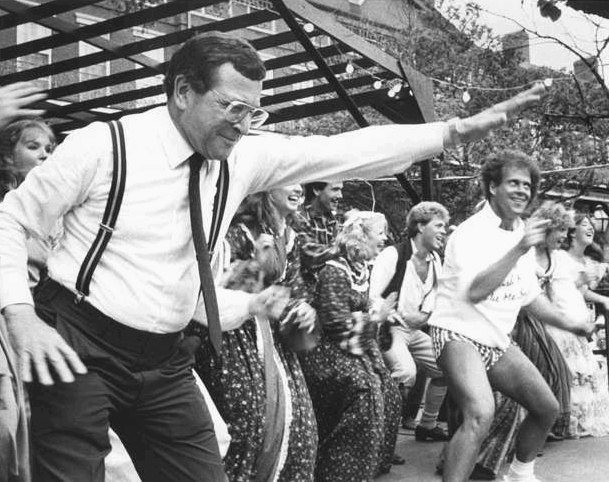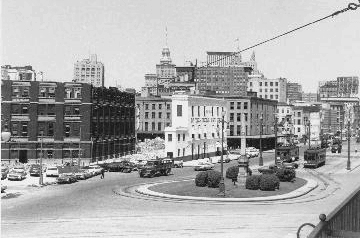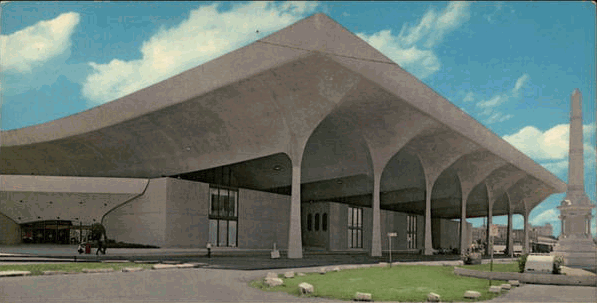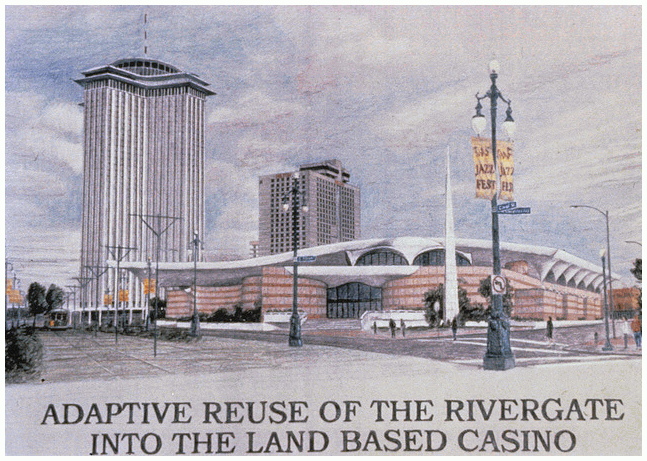|
Today in New Orleans History |
|
|
November 12


Drummer Robert "Bob" French, led of The Tuxedo Jazz Band from 1977 until his death
on November 12, 2012 at the age of 74. As a child, he took drumming lessons from Louis Barbarin
and, in his professional career, performed with James Booker, Art Neville, Charles Neville,
Kidd Jordan, Alvin Batiste, Earl King, Snooks Eaglin, Fats Domino,
and Dave Bartholomew. Mr. French was also a WWOZ radio host. Actor Nicholas Cage's property, the LaLaurie house ("Most Haunted House in America") named for former owner Delphine LaLaurie who mistreated her slaves, was foreclosed and sold at auction on November 12, 2009. On November 12, 1999, HCI Construction and Design submitted plans for renovation of the American Can Multi-Use Building at 3700 Orleans Avenue. Helvetia "Vet" Boswell, born in Birmingham, Alabama
on May 20, 1911, died on November 12, 1988. She was a member of The Boswell Sisters -- nationally
popular close harmony 1930 singing group which were considered the model for the Andrews Sisters. The group
included sisters Martha Boswell (June 9, 1905 – July 2, 1958) and Connie
(Connee) Boswell (December 3, 1907 – October 11, 1976).
Act 170 of the 1968 Louisiana Legislature authorized the creation of a
Community Improvement Agency in and for the City of New Orleans. Local approval of the Agency came through a City Council
resolution on September 5, 1968. Two months later, on November 12, 1968, the CIA held its organizational
meeting. It was directed by a seven-member Board, appointed by the Mayor with City Council approval and administered by an
Executive Director who supervises a staff of State Civil Service employees. The Community Improvement Agency was established
as the City's urban renewal department. From its inception the CIA sought the rehabilitation of blighted areas rather than
massive slum-clearance projects. In pursuit of this goal the Agency encouraged property owners to improve their holdings
and assisted them in financing those improvements. Unrepairable structures were demolished and the properties cleared for
reuse. The CIA also implemented improvements to streets, lighting, drainage, and open space within the blighted areas. The
Lower Ninth Ward became the first project area in 1969. In the following years the Desire/Florida, Gravier, and Central City
areas were added along with the special Health Education Authority of Louisiana (HEAL) medical complex. Project Area Committees
were formed in each of the four major sections. These bodies served as the means of local citizen participation in project
planning and implementation. In 1973 the CIA became the City's action arm for the Public Improvement Programs in the
Irish Channel and Broadmoor neighborhoods. The Core Area Development District, responsible for revitalizing the New Orleans
Central Business District, chose the Agency as its planning consultant in 1975. Toward the end of the 1970s the CIA was completing
its urban renewal phase and began to act more as a citywide housing improvement body. This role was encouraged by the federal
Community Development block grant program, which provided funds for general areas of service rather than for specific projects
or sections. In the mid-1990s, the activities of the Community Improvement Agency were assumed by the New Orleans Redevelopment
Authority. (From the New Orleans Public Library.) On November 12, 1959, Bodman & Murrel & Smith submitted plans for St. Joseph Academy at 1453 Crescent Street. NORD Football photos (01-Sparky Knight; 02-Coach Don Maitland, Kepper Maitland; 03-Action shot; 04,05-Behrman Spartan Squad) from November 12, 1955. Scroll down to #131. Gregory Michael Aymond, born in New Orleans on November 12, 1949, became the fourteenth
Archbishop of New Orleans on June 12, 2009.
An invitation for a second visit to New Orleans from Mayor Charles Genois was
extended to General Andrew Jackson, who had completed his term as President of the United States, on November
12, 1839 at a meeting in the St. Louis Cotton Exchange to commemorate the twenty-fifth anniversary of the
Battle of New Orleans. A cornerstone was to be laid, commemorating the general's victories in the battle.
He arrived on board the steamer “Vicksburg,” January 8, 1840 at ten o’clock a.m., landing at the Carrollton
wharf, where an immense throng had assembled to welcome “the most distinguished citizen of the country.”
General Jackson laid the cornerstone in the Place d’Armes, on January 9, 1840. It was not until some years later that
the monument decided upon was the one of Jackson, designed by Clark Mills, which stands in the center of the ancient parade
grounds for the troops. This statue has been called the “center piece of one of the finest architectural sittings
in the world.”
The House of Representatives of the Territory of Orleans was established by Act of Congress and proclaimed by Gov. Claiborne on or about October 9, 1804. The first session was held on November 12, 1804.
It was under construction from 1964 to 1968,
at a cost of $25 million. By 1994, this building was estimated to be worth $300 million. The Rivergate had pedestrian
entrances on Canal and Poydras Streets and Convention Center Boulevard. The South Peters Street elevation was dedicated
to entrance and exit openings for the two-level subsurface 800-automobile parking garage, a long loading dock with two
access doors 20' x 20' to the first floor, and freight elevators. The caption for the postcard (above) reads: The
RIVERGATE, which covers six city squares, located where famed Canal Street meets the Mississippi River, is one of the most
uniquely constructed convention-exhibition halls in the country. Boasting 130,000 square feet of clear, unobstructed space,
with no posts or pillars; it is capable of seating more than 16,000 persons for an assembly or meeting with 733 - 10'
x 10' exhibit spaces, or a combination of both. This 13 1/2 million dollar ($13,500,000) structure will be one of the
nation's newest and finest facilities". Ground breaking ceremonies on December 4, 1964 were followed
by the driving of piles and a deep excavation to provide space for the parking garage, mechanical and electrical equipment,
stairs and escalators to move people from subsurface levels up to the first floor, and the tunnel 60' x 750' ($1.3
million). Although the Rivergate was conceived and designed as a convention-exhibition facility, it was also used
as the venue for Mardi Gras balls, high school graduations, and the lying in state of New Orleans native Mahalia Jackson
in 1972). But like the Municipal Auditorium, the Rivergate became obsolete in its usefulness as a convention and exhibition
center. The Ernest N. Morial Convention Center was being planned in 1978. As of 2006, it has about 1.1
million square feet of exhibit space, covering almost 11 blocks, and over 3 million square feet of total space. It
is the 5th-largest facility of its kind in the United States and would dwarf the old Rivergate. The
City of New Orleans then altered the zoning ordinances to allow construction of a casino at the Rivergate site.
The city issued a call for casino proposals due on August 14, 1992 which required a $50,000 payment for the privilege
of submitting a proposal, half of which was refundable to unsuccessful bidders. On November 5, 1992, Mayor
Sidney Barthelemy and the City Council picked Christopher Hemmeter-Caesar's Palace (known as the Grand Palais group) to lease
the city-owned Rivergate site for development of a casino. The lease was signed on April 27, 1993. Subsequently,
the Casino Board awarded the casino operator's license to Harrah's Jazz, a partnership of Harrah's and the Jazzville group
(all local investors). On April 15, 1993, Mayor Barthelemy and the City Council finalized the selection of
Hemmeter as the "developer" -- he later teamed with Caesar's World of Las Vegas to operate the casino in a renovated
Rivergate but soon the Hemmeter-Caesar's group proposed its demolishion to make way for a new building called Grand Palais.
This plan would include a twenty-two-inch deep pond, called Celebration Lake which would run across the foot of Canal
Street, ending at One Canal Place. And there would be a sound and laser-light show and much more including a recreation
of Bernard the colonnaded arcades at the Palace of Fine Arts in San Francisco. In the end, the only elements of the
Grand Palais scheme that were constructed were the "Casino Support Facility" -- a ten-leve, 2 1/2 block long
parking garage) which replaced a group of nineteenth-century buildings at the corner of Poydras and South Peters Streets
and the tunnel linking it to the casino. But everything else fell through. The official "wall-breaking"
ceremony took place on Friday, January 13, 1995. On this occasion, a back hoe equipped with a claw toothed bucket and
a "Harrah's" banner draped on its back climbed up the steps at the Canal-South Peters Streets entrance and began
wrecking the underside of the cement plaster entrance canopy. Much of the concrete debris was hauled to West
End at Lake Pontchartrain to be used as fill for enlargement of a park off Breakwater Drive. Although only reinforced
concrete was supposed to be dumped there, other debris was included. The nature of the debris stirred environmentalists
and their protests stopped the dumping at the West End site. On October 28, 1999, Harrah's Casino was completed
at the foot of Canal Street, three years behind schedule. From THE RIVERGATE (1968 - 1995) Architecture And Politics -- No Strangers In Pair-A-Dice |
|
|

To receive an update for each day in New Orleans history,
join our facebook page - Today in New
Orleans History.
Analytics |




 The Rivergate was designed by the local firm Curtis and Davis (Nathaniel Cortlandt Curtis Jr. (1917–1997) and Arthur
Quentin Davis (1920–2011) who had also designed the Thomy Lafon School (1954) and the Louisiana State Penitentiary
at Angola (1956) and would later design the Superdome. The undulating forms of the Rivergate's thin barrel
vaults were not whimsical but are the precise shape necessary to manage the unusually long spans required for the roof
over the column free space below. The cantilevers all around contribute to the stability of the roof structure. The selection
of six temple like bays utilized to the limit the spans between columns; the columns themselves are slender and graceful,
suited to the task of support. The Rivergate, while it stood in New Orleans, was looked upon by many as a significant
example of outstanding national and international contemporary architecture and was compared to the recognized masterpieces
of its period. The most distinguishing feature of the Rivergate was the roof. The 95,500-sq. foot South Hall
was covered by a swooping and sweeping dual curved roof. This reinforced concrete barrel-arched roof design was symbolic
of the rolling Mississippi River which flows about 500 feet from the building. Engineering News Record referred to
these "humpbacked" 1-1/2 catenary curve barrel arches 453 ft. long as having the profile of a whale. The Rivergate
roof was perhaps the longest thin shell concrete roof span that had been constructed at that time. The 34,500-sq. foot
North Hall, later called Penn Hall, in honor of its distinguished and successful manager, Herman Penn, was spanned
by steel trusses 6' deep and covered with a flat roof.
The Rivergate was designed by the local firm Curtis and Davis (Nathaniel Cortlandt Curtis Jr. (1917–1997) and Arthur
Quentin Davis (1920–2011) who had also designed the Thomy Lafon School (1954) and the Louisiana State Penitentiary
at Angola (1956) and would later design the Superdome. The undulating forms of the Rivergate's thin barrel
vaults were not whimsical but are the precise shape necessary to manage the unusually long spans required for the roof
over the column free space below. The cantilevers all around contribute to the stability of the roof structure. The selection
of six temple like bays utilized to the limit the spans between columns; the columns themselves are slender and graceful,
suited to the task of support. The Rivergate, while it stood in New Orleans, was looked upon by many as a significant
example of outstanding national and international contemporary architecture and was compared to the recognized masterpieces
of its period. The most distinguishing feature of the Rivergate was the roof. The 95,500-sq. foot South Hall
was covered by a swooping and sweeping dual curved roof. This reinforced concrete barrel-arched roof design was symbolic
of the rolling Mississippi River which flows about 500 feet from the building. Engineering News Record referred to
these "humpbacked" 1-1/2 catenary curve barrel arches 453 ft. long as having the profile of a whale. The Rivergate
roof was perhaps the longest thin shell concrete roof span that had been constructed at that time. The 34,500-sq. foot
North Hall, later called Penn Hall, in honor of its distinguished and successful manager, Herman Penn, was spanned
by steel trusses 6' deep and covered with a flat roof.  In June 1992, Louisiana House Bill 2010 (Act 384 of the 1992 Regular Session) authorized a land-based casino in New Orleans.
The legislation specifically defined the location of the land-based casino -- the Rivergate site at the foot of Canal
Street. The law did not require the Rivergate to be torn down, and it did not require a new casino to be built.
In June 1992, Louisiana House Bill 2010 (Act 384 of the 1992 Regular Session) authorized a land-based casino in New Orleans.
The legislation specifically defined the location of the land-based casino -- the Rivergate site at the foot of Canal
Street. The law did not require the Rivergate to be torn down, and it did not require a new casino to be built.
